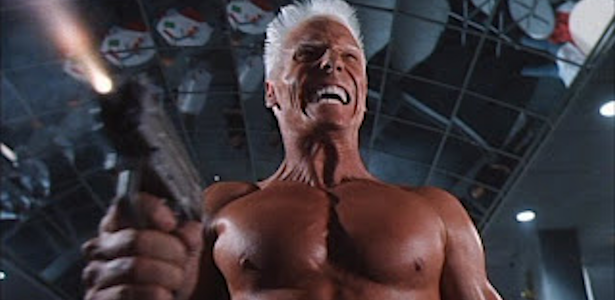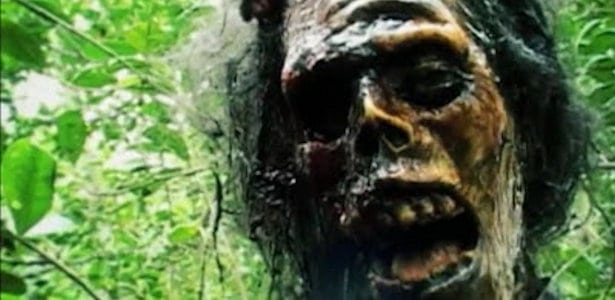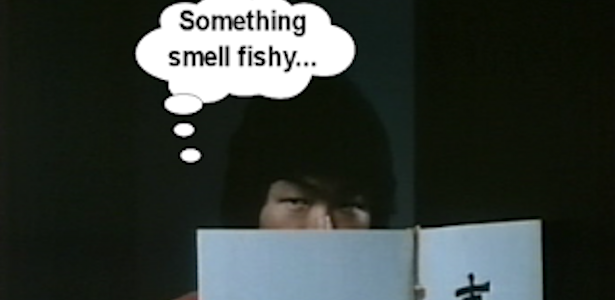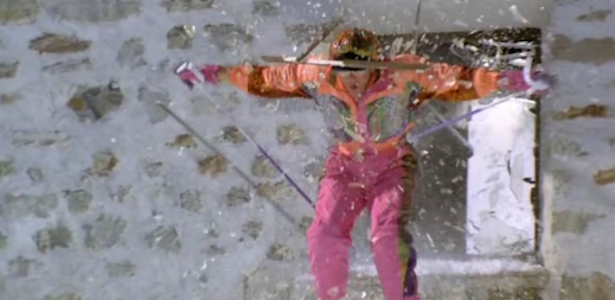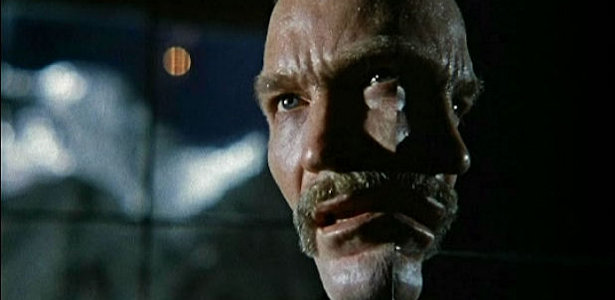In the wake of NIGHT OF THE LIVING DEAD (1968), the ripoffs came fast and furious. Some were good, some were bad and some were awesome. Falling into the latter category are Amando de Ossorio's BLIND DEAD films. From 1971-75, de Ossorio produced a quartet of films focusing on vengeful 13th century Knights Templar who return from the grave seeking victims. They are blind after having their eyeballs plucked out by birds, so they have to rely on the sounds of their victims to find them. Now that is some scary stuff and the concept has proven to be powerful and memorable enough that folks are still paying homage to the visionless villains.
Finally, where would a ripoff roundup be without some Jess Franco? Ol' Jess got his BLIND DEAD freak on in 1982 with MANSION OF THE LIVING DEAD. This is another one we haven't seen but I'm willing to be it features zooms, pointless nudity, dull stretches and Lina Romay. Severin put this one out on DVD and that is probably the best way to see it...if you dare!
GRAVEYARD OF THE DEAD (2008) aka EL RETORNO DE LOS TEMPLARIOS - Okay, let's get this bastard out of the way first. See that eye-catching DVD sleeve to the left? Go ahead, click on it to see the full size. I implore you, stare at it for a few minutes. Why? Because nothing like that happens in this piece of crap and that is about the only enjoyment you will get out of this shot-on-video BLIND DEAD ripoff, er, homage. You've heard of bottom of the barrel? Well, pick up that barrel, dig about six feet into the ground and you might find this film.
The "film" opens in 1311 with a 20-minute sequence of the Templars wandering around a village attacking women before the villagers (really five dudes) rise up and kill them all. "We shall return," cries the lead Templar (who sports a flavor saver) before he dies by hanging. Cut inexplicably to 1974 where Jorge is looking for his sister Miranda, who is a dead ringer for one of the girls the Templars killed. He finds her wandering around the old Templar stomping grounds in a daze. Seems their dad raped her (this is shown in flashbacks that you can't tell are flashbacks because they cut randomly to them and Miranda's hair is different). Meanwhile, a group of six folks are having a party nearby and the Templars rise from their shallow graves (did the music bother them?) to kill. The end.
Wow, this film is so embarrassing that other S.O.V. schlockmeisters would shake their head in shame at it. The director is credited as one Vick Campbell and he better pray that is a pseudonym. The first half is so laughably bad as the Templars wander around in flip-flops while dogs bark in the background on the soundtrack. The mic picks up so much wind that I thought I was in a wind tunnel. And Campbell is prone to reusing the same shots back-to-back, only flipping the second one so it looks like a new shot. To give you an idea of how wrongheaded this film is, one guy at the party sports a jacket that says Los Angeles Raiders on it. LOS ANGELES RAIDERS!!! That might have worked in, say, the 80s! Of course, what can you expect from a film that gets both years the film is set wrong on the back of the DVD case? The fine folks at Sinerama - makers of the FANTOM KILER (yes, KILER) - picked this one up and released it on DVD with that fancy cover above. Be afraid, be very afraid.
CROSS OF THE DEVIL (1975) - Okay, how about some of the good stuff now? This is sometimes referred to as the unofficial fifth BLIND DEAD movie. Indeed, it does feature the Knights Templar returning from the dead, but the similarities end there. Directed by John Gilling (PLAGUE OF THE ZOMBIES) and co-written by Paul Naschy, this is a occult thriller where the blind baddies take a backseat to a slow moving murder investigation.
Alfred Dawson (Ramiro Oliveros) is a hashish addicted horror writer living in London. He receives a troubling letter from his sister Justine in Spain and heads to visit her with his girlfriend Maria (the gorgeous Carmen Sevilla). Upon their arrival, they find Justine has been murdered and her much older husband Enrique Carrillo (Eduardo Fajardo) doesn't seem too upset. And neither is Carrillo's secretary Cesar del Rio (Adolfo Marsillach), who attempts to dissuade Alfred from investigating. This has some great locations and atmosphere but, unfortunately, nothing really happens for the first hour and ten minutes. The villain is exactly who you think it is so there are no surprises. There plot does involve some zombie Knights Templar so that is kind of cool, but they are only on screen for roughly a minute as Alfred disposes of them with a magical sword. Really. And, for having been dead centuries, they sure sport some pot bellies.
DON'T WAKE THE DEAD (2008) - Horror-gore shot-in-English flick from Andreas Schnaas (VIOLENT SHIT series) that has its heart in the right place. Unfortunately, everything else isn't so easy to find. A gaggle of hot chicks head to an old castle to help set up for a performance by a German metal band (amusingly, they are named Gang Loco and are a real band). What they don't know is that every 66 years an Army of Blind Dead Knights Templar rise from their graves (alongside some Nazi zombies) and it is going down - as Phil Collins said - tonight, tonight, toniiiiight. The only person there to protect them is Vincent (Ralph Fellows), a Carthusian monk in a leather jacket who has the Sword of Mecca and Flying Guillotine (!) that can defeat these blind dead bastards.
German helmer Schnaas continues to have better production values as his career progresses and there is plenty of the expected gore and nudity. Oh, and the terrible acting brings up some good laughs. But the film is still pretty rough. The worst thing is the end where - in the biggest directorial WTF? moment by a German since Uwe Boll inserted video game footage into HOUSE OF THE DEAD - Schnaas spends the time cutting between the climatic chase and the zombie band rocking out. It is totally unrelated as characters appear in both bits and it is awful. Like ever 4 minutes the action stops as he cuts back to the band playing and then back to the movie. Think NIGHT TRAIN TO TERROR without the leg warmers. Bizarre. Even funnier is that after enduring that "song" being stretched out for nearly 15 minutes, the credits start to roll and - you guessed it - that song starts playing again! Damn you, Schnaasssss! Still, I would take this over that garbage GRAVEYARD OF THE DEAD any day as Schnaas always delivers the gory goods and the Templar costumes are pretty awesome.
UNRATED: THE MOVIE (2009) - It appears Schnaas couldn't get enough of the Blind Dead (or he just wanted to get the most out of that costume) as an undead Templar appears in his latest, a co-production with Timo Rose. While we haven't seen it yet, you can check out the Templar throwing down amongst a bevy of bootleg horror luminaries ("Fat zombie!") in the trailer below. With copious gore and a zombie ripping off a bra, you know this one will be good:
Finally, where would a ripoff roundup be without some Jess Franco? Ol' Jess got his BLIND DEAD freak on in 1982 with MANSION OF THE LIVING DEAD. This is another one we haven't seen but I'm willing to be it features zooms, pointless nudity, dull stretches and Lina Romay. Severin put this one out on DVD and that is probably the best way to see it...if you dare!




